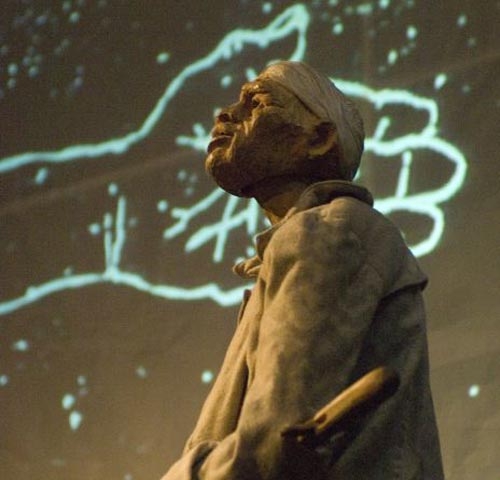 A nineteenth-century German tale of a soldier driven to violence has been taking new shape at the Hopkins Center at Dartmouth College. "Woyzeck on the Highveld" combines puppetry, live acting, and animation in a play re-set in apartheid South Africa in the 1950’s.
A nineteenth-century German tale of a soldier driven to violence has been taking new shape at the Hopkins Center at Dartmouth College. "Woyzeck on the Highveld" combines puppetry, live acting, and animation in a play re-set in apartheid South Africa in the 1950’s.
Georg Buchner’s "Woyzeck" is based on a true story about a downtrodden barber who was executed for stabbing his wife to death. This is an adaptation by the Tony-award winning, Handspring, a puppet company from Cape Town, South Africa. Their version is about a black servant to a cruel military master. The title character is also used as a guinea pig by an uncaring doctor, and cuckolded by the woman he loves.
Basil Jones is co-director.
"I always think of Woyzeck as being a play about a man who is humiliated at work by his boss, being unable to fight back at his boss and taking out on his humiliation on the person he loves most, namely his wife," Jones said.
Jones’s partner in life and work, co-Director Adrian Kohler, says even though South Africans are no longer living under Apartheid, the 1992 adaptation set in a mining town still rings all too true.
"With the mining strikes that we are having at the moment, with the poaching of our rhinos which has increased epidemic proportions because in Vietnam and Korea rhino horn is regarded as a cure-all for various ailments and an aphrodisiac to some," Kohler said. He added the play continues to resonate 20 years after its debut.
Many critics who saw the original production of "Woyzeck on the Highveld" were impressed by the ability of wooden figures to convey human emotion. Their operators are seen on stage, using sticks or their own hands to create the puppets’ movements and gestures. Behind them a screen projects animated charcoal drawings that suggest what is going on inside the puppets’ minds as they move through short, poignant scenes. For co-director Jones, being a puppeteer is participating in "that ancient form of theater which is about giving life to things. It’s a shamanistic act and it’s also sometimes quite a painful act. You have to be in an unnatural position in order to give the puppets a natural look," he said.
There is only one human character in the cast. He’s called the barker – a slightly ominous narrator who bridges the world between puppet and audience. The barker is portrayed by Mncedisi Shabangu, a South African actor who comes from the kind of mining region where the play is set.
Shabangu and the directors and cast members have spent a week in residence at Dartmouth, giving workshops and talks. At one dinner, Shabangu said it’s taken time to learn how to interact with inanimate objects on stage.
"I thought it was a bit frustrating but as time went on and then getting to understand it and perform it over and over again it gave me a much better insight into the relationship between a puppet and an actor," he said.
What really interests Shabangu is another, more thematic relationship in this play-the tension between rich and poor members of all societies.
"It’s basically that whole concept that the rich needs the poor to survive," he explained.
But, he added, the poor also need the rich, in a way, to know how poor they are. The play also examines the line between sinners and victims. Near the end, Woyzeck confronts his accusers-accusingly.
"What do you want, you think I killed someone? Am I a murder? Look at yourselves!" he tells his gossipy critics.
For co-director Kohler, moments like this are especially engaging because puppets rely on viewers as well as actors to bring them, in a sense, to life. "And I think their reliance on the imagination of every member of the audience is what makes puppet theater very strong," he said.
The show runs at the Hopkins Center Friday, September 21, and Saturday, September 22.